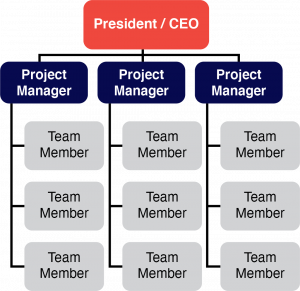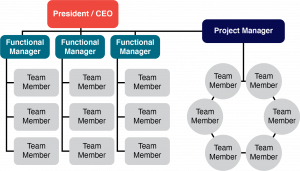2.2. Structures
There are three broad structures by which an organization can be organized: functional, matrix, and projectized. These structures represent a continuum, from structures where the project manager has very little authority (functional) to those where project managers have very broad power (projectized) (See Figure 2.1).
There have been many studies about the impact that organizational structure has on project success, and it is not uncommon for corporations to change their organizational structure in order to increase their relative success in executing projects on time and within budget. This type of change takes great effort and may take a long period of time to fully implement. Instead of changing their entire structure, an organization may elect to create a dedicated project team in order to carry out a critical project without reorganizing the entire enterprise. This way, they can get many of the same benefits of the projectized organization without reorganizing the enterprise. This approach is not without risk, as we’ll explore in the section on dedicated project teams.

Functional Organizations
Perhaps the least project-focused type of organization is functional organization. Large organizations are traditionally organized by function into various departments, with staff in each department reporting to a departmental manager or head of department. This allows for groupings of specialists within the organization where they can work together, share knowledge, and prioritize their work. Traditional functional departments might include:
- Human resources
- Accounting
- Procurement
- Marketing
- Sales
- Shipping
These functional units work independently of each other, and the functional managers serve as conduits for communications and collaboration (See Figure 2.2). This type of structure is very efficient for operations management where continuous process improvement can be conducted on all regular departmental operations. However, it is not optimal for the completion of projects.
Projects often require work across disciplines. In the functional organization, with staff isolated inside their departmental “silos,” communication is directed through the functional managers. These managers often have differing priorities, which can make communications slow and error-prone in a functional organization.

The success of projects within a functional organization depends on functional managers working together and cooperating. While someone may be designated as the project manager for a particular project, that person may not have much authority (See Figure 2.3). Often titles such as Project Coordinator, Project Scheduler, or Project Expediter will be used instead. Regardless of title, those in charge of projects are often put in the role of simply trying to maintain a schedule of what is happening.

PMI identifies the following project characteristics for projects conducted in functional organizations:
- Project Manager’s Authority: Little or None
- Resource Availability: Little or None
- Who Manages the Project Budget: Functional Manager
- Project Manager’s Role: Part-time
- Project Management Administrative Staff: Part-time
Projectized Organizations
Projectized organizations are at the opposite end of the organizational spectrum from functional organizations. Organizational energy and resources are focused on completing projects rather than ongoing operations. In a projectized organization, operations are minimal and the project manager has great authority over resources and personnel decisions. Projectized organizations may have organizational units called departments and these groups either report directly to the project manager or provide support services to projects. In the project-based structure, personnel are specifically assigned to the project and report directly to the project manager (See Figure 2.4).
As you can imagine, employees in this type of environment are able to focus their loyalty on a project rather than their particular discipline. Not all people can succeed in such an organization, as they must adapt to the leadership styles and organizational skills of different project managers.
This is the most efficient organizational type for conducting projects, and it is used in those types of organizations that bid on and undertake large projects—military, industrial, scientific, etc.— that may last several years.
Examples of project-based organizations include construction companies, aeronautical manufacturers such as Lockheed Martin, and many software development companies. This type of organizational structure can put additional stress on employees as they have no home to return to once their project is over if they are not selected for a subsequent project. However it is generally considered ideal for project management since there is a significant reduction in the layers of bureaucracy that a project manager must navigate. PMI identifies the following project characteristics for projects conducted in projectized organizations:
- Project Manager’s Authority: High or Absolute
- Resource Availability: High or Absolute
- Who Manages the Project Budget: Project Manager
- Project Manager’s Role: Full-time
- Project Management Administrative Staff: Full-time

Matrix Organizations
While the functional structure may work well in times of little change, it has some serious limitations when the success of a company depends on being adaptable. A matrix structure tries to combine the strengths a functional organization provides for operations management with the strengths a projectized organization provides for project management. In a matrix organization, the functional and project manager share authority and responsibility. This can lead to several negatives:
- Employees can have two supervisors to whom they have to report, breaking the rule of a solitary chain of command.
- Employees have to balance their work between the needs of the projects, they are working on, and their functional unit.
- Supervisors may find that it is more difficult to achieve a consistent rate of progress since employees are often pulled in different directions.
- Costs and communication channels can increase.
However, there are several advantages to a matrix structure in terms of projects:
- It significantly disrupts the communication “silos” of a functional organization, creating a more horizontal structure for teams and increasing the flow of information.
- It allows people to concentrate on their areas of specialty and bring that strength to current projects.
PMI recognizes three types of matrix structures, as described below (See also Figure 2.5).
- Weak Matrix: The project manager has less authority over resources and people than the functional managers. Project managers in a weak matrix may go by other titles such as a project coordinator or project scheduler.
- Balanced Matrix: In a balanced matrix, the project manager and functional managers equally share authority over resources and staff. This allows the organization to experience the “best of both worlds” by receiving the benefits of a projectized organization and functional organization at the same time. However, this system presents many challenges:
- Functional managers and project managers have to work well together and maintain regular communications. Staff will have two managers to whom they have to report, breaking the concept of the chain of command and organization.
- If functional and project managers have conflicting priorities, subordinates may be unable to meet expectations.

- Strong Matrix: In a strong matrix, the project manager has more direct control over resources and staffing, while the functional manager will provide support to the project staff in terms of hiring, technical expertise, and professional development. Of all the matrix structures, this is the one in which the project manager has the most authority, and the functional manager has the least.
Dedicated Project Team
Many functional organizations find that they often need to carry out important projects but do not want to change their entire organizational structure. Recognizing the advantages that are achieved by giving authority to a project manager, functional organizations often organize dedicated project teams where a project manager can have authority over the staff assigned to that particular project. The project manager and project team members are sometimes located in a special office, away from the desks and duties that they normally have within the functional organization (See Figure 2.6). This can be a very effective way to complete projects. However, some difficulties can arise:
- Temporary loss of staff from the functional groups.
- Integration of project team members back into the functional organization after the project is completed can be difficult.
- An “us versus them” mentality, where the people on the project team are deemed to be more special than those working in the functional departments. There have been numerous case studies of conflict arising from dedicated project teams.

A classic case of the use of a dedicated project team—and the problems it can cause to the functional organization—was when Steve Jobs picked the best and brightest engineers from Apple to work on the development of the Macintosh computer. The project was very successful, but there was a lot of tension between the project team and the functional organization.
“3.1: Organizational Structures” from Project Management Fundamentals by J Scott Christianson is licensed under a Creative Commons Attribution-NonCommercial-ShareAlike 4.0 International License.

